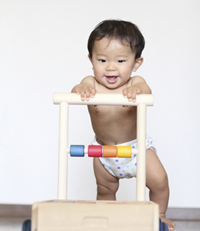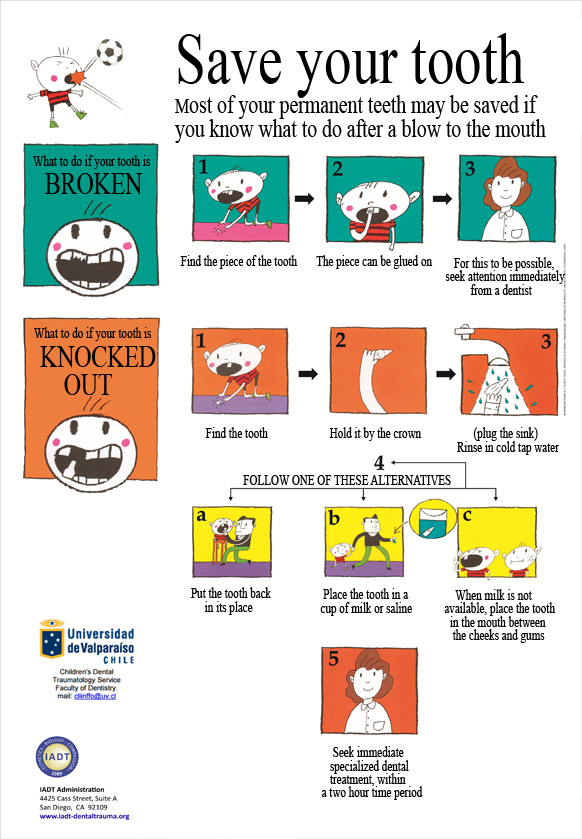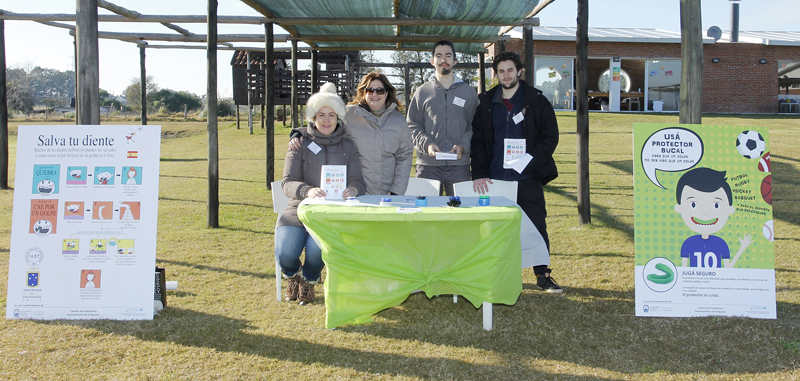Information for patients

Information about dental trauma for the public, Contains information about how to prevent and first aids for dental trauma
Link here to >>Find an IADT Dentist
Scroll down for Save Your Tooth Poster ( see below )
Link here to >>Find an IADT Dentist
Scroll down for Save Your Tooth Poster ( see below )
Click Here to >> Donate to support the efforts of the IADT - A non-profit organization
 FREE IADT Dental Trauma First Aid App How to take care of a dental trauma at the scene of an accident. This app shows what to do... Link to ToothSOS App Privacy Policy
|
What you should know about dental injuries of primary teeth?
 |
When the child first starts exploring the world by themselves, with the help of their first baby walker, they are exposed to falls that can affect their face and teeth. During the first years of life, the primary teeth are very closely related to the permanent teeth, which are forming inside the bone.When injury occurs to the primary teeth in this period, it can affect the aesthetics of the permanent teeth, which will present at approximately eight years of age with whitish marks or a deformation in the crown depending on the extent of the injury. The most serious lesions on the primary teeth can cause complications to the permanent successors; ie. intrusion (when the tooth is buried in the gum) and avulsion (when the tooth is knocked out). Both situations are more serious the younger the child is. The primary tooth should not be replaced once it has been knocked out. |
How to prevent dental trauma in primary teeth?
Do not use baby walkers.
Do not let children use roller skates without protection.
Teach your children to:
- Look after their teeth as well as that of their friends’ teeth when playing by not knocking their teeth with heavy objects.
- Watch out for possible obstructions that they can trip themselves up on.
- Do not push when playing.
- Stay seated on the swing and do not jump off when the swing is in motion.
- Use the stairs when getting out of the swimming pool.
If the child participates in sports such as rugby, hockey, karate, riding on a bike, wintersports (i.e. skiing) a skate board or any activity that involves potential trauma to the facial area, make sure that the child uses a helmet or mouth protector
Do not let children use roller skates without protection.
Teach your children to:
- Look after their teeth as well as that of their friends’ teeth when playing by not knocking their teeth with heavy objects.
- Watch out for possible obstructions that they can trip themselves up on.
- Do not push when playing.
- Stay seated on the swing and do not jump off when the swing is in motion.
- Use the stairs when getting out of the swimming pool.
If the child participates in sports such as rugby, hockey, karate, riding on a bike, wintersports (i.e. skiing) a skate board or any activity that involves potential trauma to the facial area, make sure that the child uses a helmet or mouth protector
What to do in case of a fall that affects a permanent teeth?
First, you must consult a dentist immediately after the accident has occurred. This measure has many advantages:
1) There is more possibility of conserving the tooth's vitality.
2) A conservation treatment will be applied.
3) There is a better prognosis.
4) Future complications and high cost treatments are prevented.
It is of vital importance that all traumatic injuries are diagnosed, treated, and controlled in time (at least within five years).
1) There is more possibility of conserving the tooth's vitality.
2) A conservation treatment will be applied.
3) There is a better prognosis.
4) Future complications and high cost treatments are prevented.
It is of vital importance that all traumatic injuries are diagnosed, treated, and controlled in time (at least within five years).
What to do if a permanent tooth is broken or knocked out?
1) Find the tooth. Hold the tooth by the crown (the white part), not by the root (the yellow part).
2) Replant immediately, if possible.
3) If contaminated, rinse shortly with cold tap water and put the tooth back in its place. This can be done by the child or an adult.
4) Hold the tooth in place. Bite on a handkerchief to hold it in position and go to the dentist immediately.
5) If you can not put the tooth back in, place it in a cup of milk or saline. When milk or saline are not available, place the tooth in the child's mouth (between the cheeks and gums)
6) Seek immediately specialized dental treatment
Children between 7 and 10 years of age are more exposed to suffer avulsion due to the elasticity of the bone at this age.
Good oral hygiene is absolutely necessary in the healing period
2) Replant immediately, if possible.
3) If contaminated, rinse shortly with cold tap water and put the tooth back in its place. This can be done by the child or an adult.
4) Hold the tooth in place. Bite on a handkerchief to hold it in position and go to the dentist immediately.
5) If you can not put the tooth back in, place it in a cup of milk or saline. When milk or saline are not available, place the tooth in the child's mouth (between the cheeks and gums)
6) Seek immediately specialized dental treatment
Children between 7 and 10 years of age are more exposed to suffer avulsion due to the elasticity of the bone at this age.
Good oral hygiene is absolutely necessary in the healing period

Please feel free to print and distribute the following posters and Save a Tooth!*
|
|||
|---|---|---|---|
Translation by: Dr. Mayssoon Dashash |
Translation by: Dr. Sidhartha Sharma and Krunal Tabiyar |
Translation by: Dr. Mahendra Kumar sahu, Dr. Sarita, and Dr. Virat Galhotra |
|
Translation by: Dr. Talar Zeitounlouian |
Translation by: Dr. Costas Onisiphorou |
Translation by: Dr. Jamileh Ramezani |
|
Translation by: Dr. Amandeep Kaur, Dr. Premlata Devi, Dr. Sh Priyadarshini, Dr. Deepak BS |
Translation by: Dr. Adeleke Oginni |
Translation by: Dr. Joanna Baginska |
|
Translation by: Dr. Muhammad Asyraf Bin Mustafa |
Translation by: Dr. Liran Levin |
Translation by: Dr. Joana Marques and Dr. Paulo J. Palma |
|
Translation by: Dr. Aitzol Areso Odriozola and Kepa Susperregi |
Translation by: Dr. Nitesh Tewari |
Translation by: Dr. Renato Lenzi Brazilian Sign Language Translation: Click to View Video Translation by: Francisco Montagner and Carina Rebello Cruz |
|
Translation by: Dr. Pooja Singh and Dr. Md Arif Hossain |
Translation by: Dr. Sándor Balázs |
Translation by: Dr. Ashima Goyal and Dr. Tundup Dolker |
|
Translation by: Dr. Marija Obradovic |
Translation by: Dr. Asgeir Sigurdson |
Translation by: Dr. Liran Levin and Dr. Michael Saminsky |
|
Translation by: Dr. Presiyan Krastev |
Translation by: Dr. Billy Sujatmiko |
Translation by: Dr. Amrita Chawla, Dr. Sarita Gill, Dr. Sidhartha Sharma, Dr. Vijay Kumar,and Dr. Ajay Logani |
|
Translation by: Dr. Nyan Linn Naing |
Translation by: Dr. Silvia Pizzi |
Translation by: Dr. Amrita Chawla, Dr. Sarita Gill, Dr. Sidhartha Sharma, Dr. Vijay Kumar,and Dr. Ajay Logani |
|
Translation by: Dr Montse Mercadé and Dr. Jordi Cadellans |
Translation by: Dr. Muhammed Al-Huda Ballouk and Professor Dr. Mohamed Altinawi / Proofread by Dr. Koyo Takimoto |
Translation by: Dr. Chandra G. Herath |
|
Translation by: Dr. Li Shu |
Translation by: Dr. Ashwin P S and Dr. Siri P B |
Translation by: Dr. Luka Hocevar |
|
Translation by: Dr. Bruno Špiljak |
Translation by: Dr. Sung Chul Choi |
Translation by: Dr. Marie Therese Flores |
|
Translation by: Dr. Radovan Žižka |
Translation by: Dr. Ilze Maldupa |
Translation by: Dr. Ida Fröse |
|
Translation by: Anne-Marie Folmer, Josephine Solgaard Henriksen, and Eva Lauridsen |
Translation by: Dr. Greta Lodiene |
Translation by: Dr. Chellaswamy Savarimalai |
|
Translation by: Dr. Els Tijskens |
Translation by: Dr. Soo Suet Yeo |
Translation by: Dr. Sivakumar Nuvvula |
|
Translation by: Dr. Marie Therese Flores |
Translation by: Dr Kevin George Varghese, Dr Joe Mathew Cherian, Dr Nirmal Kurian, Dr Hemiya Anna Thomas |
Translation by: Dr. Phumisak Louwakul |
|
Translation by: Dr. Anastassia Kuldmaa |
Translation by: Dr. Amandeep Kaur, Dr. Premlata Devi, Dr. Sh Priyadarshini, Dr. Deepak BS |
Translation by: Dr. Aditi Kapur and Dr. Tundup Dolker |
|
Translation by: Dr. Cecilia Bourguignon |
Translation by: Dr. Aranta Chindane |
Translation by: Dr. Fatih Sengul |
|
Translation by: Dr. Maria de Los Angeles Garcia Lopez |
Translation by: Dr. Amandeep Kaur, Dr. Premlata Devi, Dr. Sh Priyadarshini, Dr. Deepak BS |
Translation by: Dr. Stanislav Heranin |
|
Translation by: Dr. Marika Zurmukhtashvili |
Translation by: Dr. Amandeep Kaur, Dr. Premlata Devi, Dr. Sh Priyadarshini, Dr. Deepak BS |
Translation by: Dr. K. Gauba and Dr. Umer Mukhtar |
|
Translation by: Dr. Roger Enz |
Translation by: Navid Masoumi |
Translation by: Dr. William Ha |
|
Save Your Tooth |
To participate in the translation project, or submit your photo "Poster in Action", please contact: IADT@iadt-dentaltrauma.org |
||
Dr. Amzallag preventing traumatic dental injuries at the soccer field - Printed handouts for coaches, parents and players!
|
|||
Banner image from Some rights reserved by M@rg



